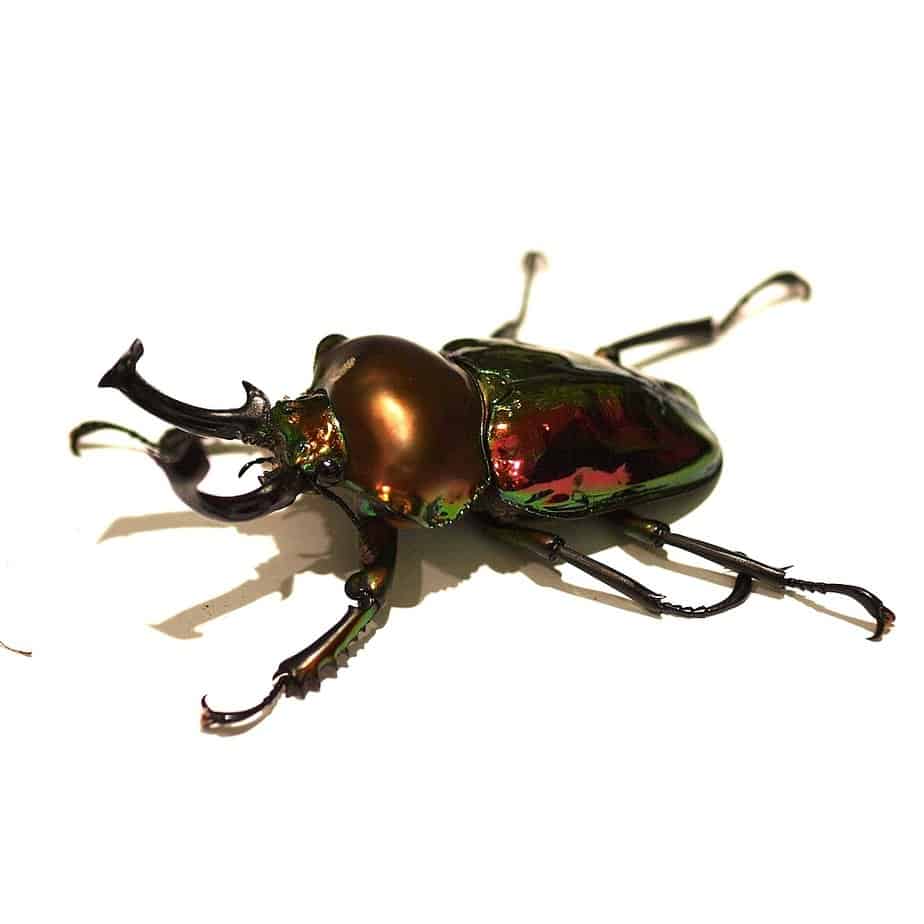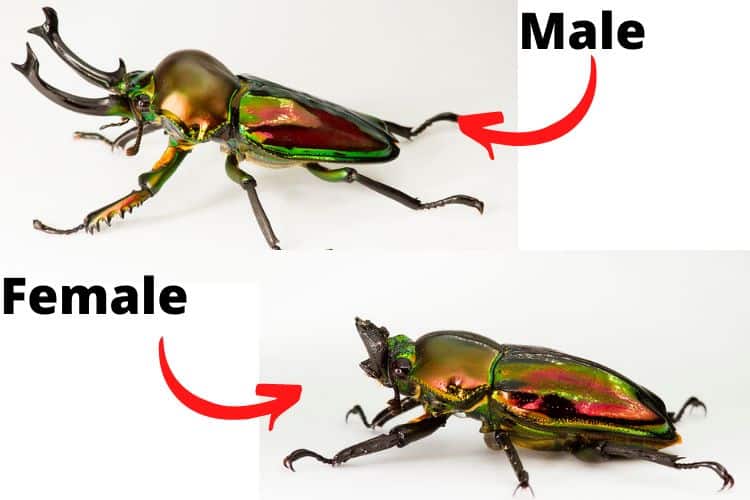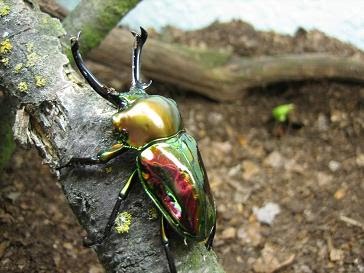The Rainbow Stag Beetle (Phalacrognathus muelleri) is a popular choice for new as well as experienced insect keepers. They’re popular for being very beautiful and easy to care for.
With bright metallic colors over its elytra, the Rainbow Stag Beetle is a welcome addition to any hobbyist’s collection. If you’re interested in getting one of these beautiful insects, we’ve gathered all the information you need to know if it’s the right fit for you and how to properly care for them.

Rainbow Stag Beetle Care Sheet
| Name of species | Phalacrognathus muelleri |
| Family | Scarabaeidae |
| Common name | Rainbow Stag Beetle |
| Category | Beetle |
| Type | Stag beetle |
| Native location | Australia and New Guinea |
| Size | 2.8 inches (7cm) |
| Diet | Decaying wood, sap, nectar, and fruits. |
| Lifespan | 12-18 months |
| Experience level | Beginner |
Rainbow Stag Beetle overview
The Phalacrognathus muelleri gets the name of Rainbow Stag Beetle (RSB) for its beautiful colors. Native to Queensland in Australia and New Guinea, these stag beetles spend most of their time deep into rotten logs, bark, and soil.
They can also fly pretty well, and they’re easy to spot mid-flight, thanks to their bright colors.
This insect feeds on rotten bark, sap, fruits, and nectar, so it doesn’t have trouble finding food where it stays; however, since it’s so bright, it becomes an easy catch for birds and other predators when it’s flying.
Appearance & Variants

If you’ve ever seen an RSB, you’ll remember it your whole life. It’s a stag beetle with bright metallic colors over its elytra and a slightly duller color in its pronotum.
The colors covering the elytra are usually tones of green, blue, and even sometimes red. There are also rare cases where you’ll see a purple specimen. It’s a strange occurrence, and the rarity of this color makes them more expensive.
The RSB has sexual dimorphism, so males and females won’t look the same way. As happens with stag beetles, male RSBs have two large mandibles protruding as horns on both sides of its head.
Females don’t have horns, and they’re also much smaller, so it’s easy to tell the difference between males and females.
The Phalacrognathus muelleri is also easy to identify as male or female as a grub. Female larvae have a white or yellow spot at the back of their abdomen, while males don’t. This makes it possible for you to determine the sex of larvae in a pet store!
Price
Rainbow Stag Beetles can only be bought with a special permit in the US. This drives the prices up, so an adult will cost you around $200 if you get it locally.
However, you can get Rainbow Stag Beetles in the rest of the world for around $40; $50 if it’s a purple specimen.
Behavior and Temperament
Rainbow Stag Beetle spends most of its life underground. It’s a peaceful and harmless insect, so it’s an ideal pet for kids that are interested in learning more about beetles.
Males shouldn’t be kept together as they’re territorial and prone to fighting. They’ll fence with their mandibles over the chance of reproducing and claiming territory, so you’ll want to set them apart, or else they’ll get hurt.
Females can be kept together, and you can throw a male into that mix if you want them to breed; however, make sure that you don’t leave the male with the females for too long, or else it may die from exhaustion.
Handling a Rainbow Stag Beetle is easy and safe for you; just be concerned about the beetle’s welfare while you do it. RSB grubs are very fragile, so you should be careful not to drop them.
Adults can fly, so there’s less risk of them falling; however, for this same reason, you shouldn’t handle them close to structures that may harm them mid-flight such as ceiling fans.
Caring for a Rainbow Stag Beetle

Temperature and Humidity
The Rainbow Stag Beetle lives in sclerophyll forests and rainforests. Both are known for high humidity and mid-to-high temperature, with plenty of tall trees and vegetation that favor this insect.
Adults thrive in temperatures from 65°F to 75°F, while grubs enjoy slightly hotter environments of 72°F to 77°F. The humidity levels should be high, so try to keep it above 70%.
Substrate
The substrate required by adult RSBs isn’t the same as the larvae. Adults need a moisture-retaining substrate that’s soft for them to burrow, so mixtures based on coconut fiber do wonders for them.
Grubs instead require a substrate that works as their food supply, so you should give them moist flake soil or kinshi.
It’s said that kinshi is better for the males, so if you’re able to afford it, it’ll make your males live longer. As for the depth, three inches of substrate should be enough for them to burrow comfortably.
Tank
Grubs don’t require large tanks during their growing stages. Since they’ll spend most of their time underground, safe containers with enough substrate can work at one or two gallons of volume.
Adults, if kept individually, will do well as long as the tank is three times as long, two times as wide, and two times as tall as they are.
However, they enjoy having more space, and you should consider at least five gallons if you want to keep several together in the same enclosure.
As for the decorations, Rainbow Stag Beetles love having places to hide. Make sure to place small plants, branches, and bark inside the enclosure.
Also, if you want them to breed, they’ll need a piece of log so the female can bury the eggs inside.
Watering
Rainbow Stag Beetles don’t need water dishes or free bodies of water. Since they get their hydration from their food and the soil’s humidity, make sure to mist the substrate frequently to keep it moist.
Don’t water the substrate so much that you get water at the bottom of the tank, and your beetles should be fine.
Diet & Feeding
Rainbow Stag grubs are easy to feed since all you need is to give them the right type of substrate.
As for adults, sweet fruits such as bananas, apples, and grapes are great for them. Just make sure to remove all remains before they ferment, or else you may have a fungi problem in the enclosure.
A food plate with beetle jelly will always be the best choice since it specializes in providing the right nutrients for adults. Homemade recipes are available online if store-bought jellies are out of your price range.
Fun Facts about the Rainbow Stag Beetle
- The RSBs found in Australia and New Guinea are considered two different subspecies. Those found in Australia are Phalacrognathus muelleri muelleri, while New Guinea boasts the striking Phalacrognathus muelleri fuscomicans.
- The Rainbow Stag Beetle was named in honor of Baron Ferdinand Von Muelle, a German-Australian physician.
- If you ever see a dead RSB, you’ll notice its dull colors closer to reddish-brown instead of metallic green. This is because Rainbow Stag Beetles don’t maintain their beautiful colors after they’re dead.
Final words: Is the Rainbow Stag Beetle right for you?
Rainbow Stag Beetles are great pets. They are ideal for kids since they’re harmless and beautiful, and they make a great addition to any collection.
These stunning insects are a great way introduction to the insect-keeping world but are also very suitable for more experienced keepers. They are low maintenance, and interesting to look at, and you can even handle them carefully.
If this insect is not for you, you might be interested in checking out the Japanese Rhinoceros, Hercules, or Atlas Beetle instead.
- How Long Do American Eskimo Dogs Live? Important Factors and Care Tips - September 29, 2023
- Do American Bulldogs Need Grooming? Essential Tips and Care Guidelines - September 29, 2023
- Do Bengal Cats Enjoy Playing? Essential Tips for Keeping Them Active - September 29, 2023